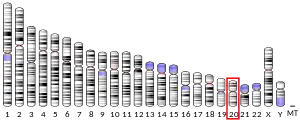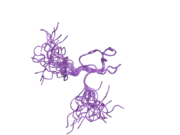RanBP-type and C3HC4-type zinc finger-containing protein 1 (also known as HOIL-1) is a protein that in humans is encoded by the RBCK1 gene.[5]
The protein encoded by this gene is similar to mouse UIP28/UbcM4 interacting protein. Alternative splicing has been observed at this locus, resulting in distinct isoforms.[5]
HOIL-1 is an E3 ubiquitin ligase and a part of the linear ubiquitin chain assembly complex (LUBAC), the only known ubiquitin ligase generating linear (Met1) polyubiquitin linkages.[6] Although HOIL-1 isn’t responsible for the linear ubiquitin generation, it is a necessary component of LUBAC and ensures its proper assembly and function.[7] Interestingly, unlike most E3 ubiquitin ligases, HOIL-1 is able to catalyze oxyester bond formation between the C-terminus of a ubiquitin monomer and Ser/Thr of a different protein. This recently discovered function of HOIL-1 has so far been described in the context of MyD88 signaling.[8] Additionally, a catalytically inactive mutant of HOIL-1 (HOIL-1C458S) led to prolonged IKK activation and increase of inflammatory cytokine production by cytotoxic T cells. The proposed mechanism is that the ester-linked ubiquitin chains limit the size of isopeptide-linked (K63 and/or M1) ubiquitin chains.[9]
Clinical significance
A family quartet was found with two children, both affected with a previously unreported disease, characterized by progressive muscular weakness and cardiomyopathy, with normal intelligence. During the course of the study, one additional unrelated patient was found with a comparable phenotype. From whole-genome sequence data, RBCK1, a gene encoding an E3 ubiquitin-protein ligase, was identified as the most likely candidate gene, with two protein-truncating mutations in probands in the first family. Sanger sequencing identified a private homozygous splice variant in RBCK1 in the proband in the second family, yet single-nucleotide polymorphism (SNP) genotyping revealed a 1.2Mb copy-neutral region of homozygosity covering RBCK1. RNA-Seq confirmed aberrant splicing of RBCK1 transcripts, resulting in truncated protein products.[10] Ten other individuals with mutations in RBCK1 and overlapping phenotypes have been identified.[11]
References
- 1 2 3 GRCh38: Ensembl release 89: ENSG00000125826 - Ensembl, May 2017
- 1 2 3 GRCm38: Ensembl release 89: ENSMUSG00000027466 - Ensembl, May 2017
- ↑ "Human PubMed Reference:". National Center for Biotechnology Information, U.S. National Library of Medicine.
- ↑ "Mouse PubMed Reference:". National Center for Biotechnology Information, U.S. National Library of Medicine.
- 1 2 "Entrez Gene: RBCK1 RanBP-type and C3HC4-type zinc finger containing 1".
- ↑ Kirisako T, Kamei K, Murata S, Kato M, Fukumoto H, Kanie M, et al. (October 2006). "A ubiquitin ligase complex assembles linear polyubiquitin chains". The EMBO Journal. 25 (20): 4877–4887. doi:10.1038/sj.emboj.7601360. PMC 1618115. PMID 17006537.
- ↑ Peltzer N, Darding M, Montinaro A, Draber P, Draberova H, Kupka S, et al. (May 2018). "LUBAC is essential for embryogenesis by preventing cell death and enabling haematopoiesis". Nature. 557 (7703): 112–117. Bibcode:2018Natur.557..112P. doi:10.1038/s41586-018-0064-8. PMC 5947819. PMID 29695863.
- ↑ Kelsall IR, Zhang J, Knebel A, Arthur JS, Cohen P (July 2019). "The E3 ligase HOIL-1 catalyses ester bond formation between ubiquitin and components of the Myddosome in mammalian cells". Proceedings of the National Academy of Sciences of the United States of America. 116 (27): 13293–13298. Bibcode:2019PNAS..11613293K. doi:10.1073/pnas.1905873116. PMC 6613137. PMID 31209050.
- ↑ Petrova T, Zhang J, Nanda SK, Figueras-Vadillo C, Cohen P (October 2021). "HOIL-1-catalysed, ester-linked ubiquitylation restricts IL-18 signaling in cytotoxic T cells but promotes TLR signalling in macrophages". The FEBS Journal. 288 (20): 5909–5924. doi:10.1111/febs.15896. PMID 33932090. S2CID 233472285.
- ↑ Wang K, Kim C, Bradfield J, Guo Y, Toskala E, Otieno FG, et al. (2013). "Whole-genome DNA/RNA sequencing identifies truncating mutations in RBCK1 in a novel Mendelian disease with neuromuscular and cardiac involvement". Genome Medicine. 5 (7): 67. doi:10.1186/gm471. PMC 3971341. PMID 23889995.
- ↑ Nilsson J, Schoser B, Laforet P, Kalev O, Lindberg C, Romero NB, et al. (December 2013). "Polyglucosan body myopathy caused by defective ubiquitin ligase RBCK1". Annals of Neurology. 74 (6): 914–919. doi:10.1002/ana.23963. PMID 23798481. S2CID 205344695.
Further reading
- Martinez-Noel G, Niedenthal R, Tamura T, Harbers K (July 1999). "A family of structurally related RING finger proteins interacts specifically with the ubiquitin-conjugating enzyme UbcM4". FEBS Letters. 454 (3): 257–261. doi:10.1016/S0014-5793(99)00823-6. PMID 10431818. S2CID 46159115.
- Yamanaka K, Ishikawa H, Megumi Y, Tokunaga F, Kanie M, Rouault TA, et al. (April 2003). "Identification of the ubiquitin-protein ligase that recognizes oxidized IRP2". Nature Cell Biology. 5 (4): 336–340. doi:10.1038/ncb952. PMID 12629548. S2CID 20453941.
- Hillman RT, Green RE, Brenner SE (2005). "An unappreciated role for RNA surveillance". Genome Biology. 5 (2): R8. doi:10.1186/gb-2004-5-2-r8. PMC 395752. PMID 14759258.
- Tatematsu K, Yoshimoto N, Koyanagi T, Tokunaga C, Tachibana T, Yoneda Y, et al. (June 2005). "Nuclear-cytoplasmic shuttling of a RING-IBR protein RBCK1 and its functional interaction with nuclear body proteins". The Journal of Biological Chemistry. 280 (24): 22937–22944. doi:10.1074/jbc.M413476200. PMID 15833741.
- Zhang Y, Wolf-Yadlin A, Ross PL, Pappin DJ, Rush J, Lauffenburger DA, White FM (September 2005). "Time-resolved mass spectrometry of tyrosine phosphorylation sites in the epidermal growth factor receptor signaling network reveals dynamic modules". Molecular & Cellular Proteomics. 4 (9): 1240–1250. doi:10.1074/mcp.M500089-MCP200. PMID 15951569.
- Yoshimoto N, Tatematsu K, Koyanagi T, Okajima T, Tanizawa K, Kuroda S (September 2005). "Cytoplasmic tethering of a RING protein RBCK1 by its splice variant lacking the RING domain". Biochemical and Biophysical Research Communications. 335 (2): 550–557. doi:10.1016/j.bbrc.2005.07.104. PMID 16083853.
- Bayle J, Lopez S, Iwaï K, Dubreuil P, De Sepulveda P (May 2006). "The E3 ubiquitin ligase HOIL-1 induces the polyubiquitination and degradation of SOCS6 associated proteins". FEBS Letters. 580 (11): 2609–2614. doi:10.1016/j.febslet.2006.03.093. PMID 16643902. S2CID 44648698.
- Tian Y, Zhang Y, Zhong B, Wang YY, Diao FC, Wang RP, et al. (June 2007). "RBCK1 negatively regulates tumor necrosis factor- and interleukin-1-triggered NF-kappaB activation by targeting TAB2/3 for degradation". The Journal of Biological Chemistry. 282 (23): 16776–16782. doi:10.1074/jbc.M701913200. PMID 17449468.
- Wang K, Kim C, Bradfield J, Guo Y, Toskala E, Otieno FG, et al. (2013). "Whole-genome DNA/RNA sequencing identifies truncating mutations in RBCK1 in a novel Mendelian disease with neuromuscular and cardiac involvement". Genome Medicine. 5 (7): 67. doi:10.1186/gm471. PMC 3971341. PMID 23889995.






